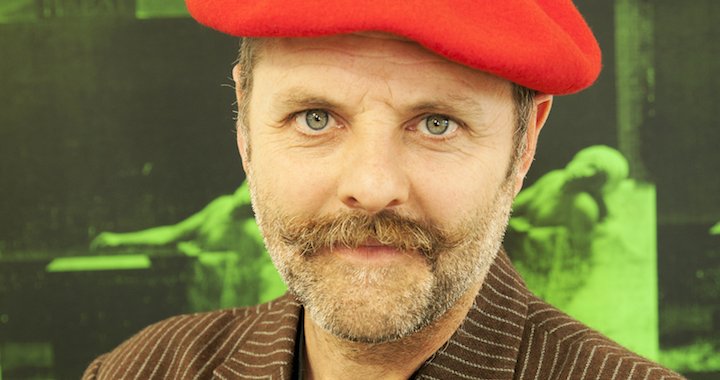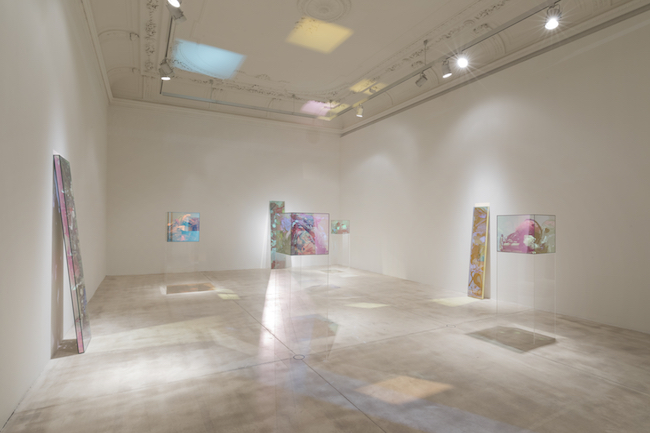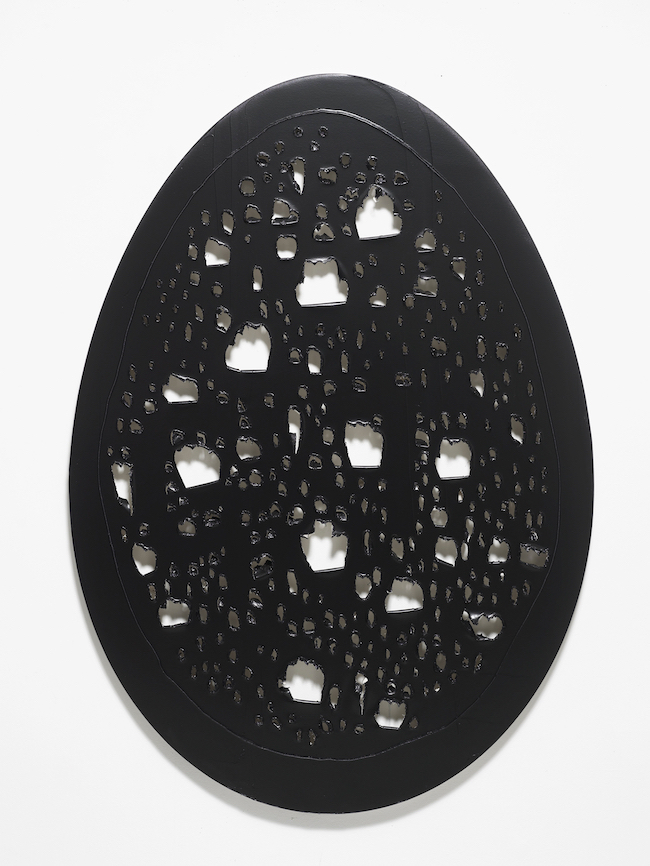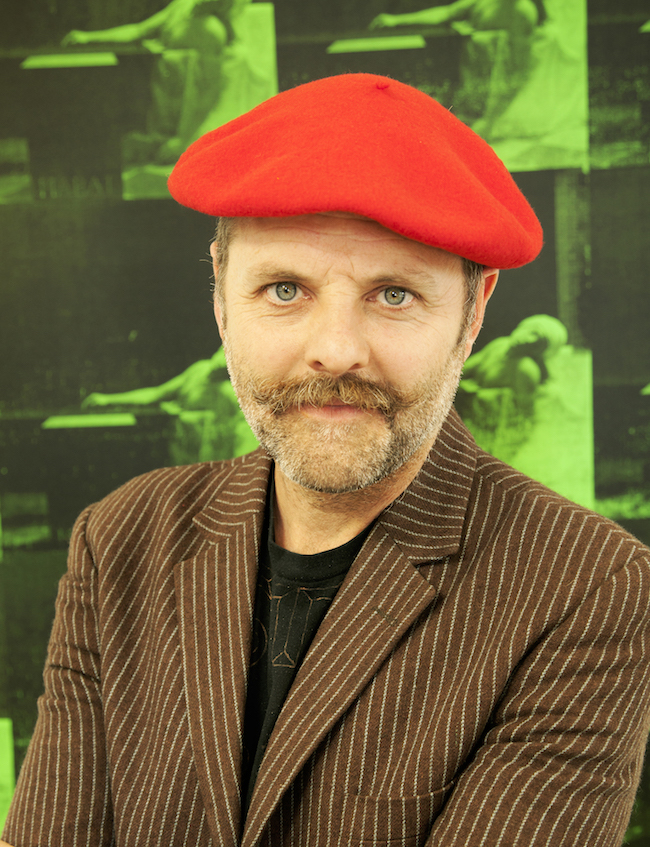
You cannot know before it breaks
An interview with Gavin Turk in Vienna
03/05/2018
About a month ago, at Galerie Krinzinger in Vienna, I had a chance to meet Gavin Turk (1967), one of the most prominent contemporary British artists. Having studien at the Royal College of Art in late 1980ies, Turk first caught the public eye when the College refused to present him with his postgraduate degree for his work Cave: it consisted only of a whitewashed, empty studio, with a heritage plaque in one corner that stated: “Gavin Turk worked here, 1989-1991”. Soon after that, art collector Charles Saatchi started including Turk's works in his collection. Saatchi was one of the biggest collectors of works by “Young British Artists” (YBA) – a loosely defined group of artists that Turk is a prominent member of. They came into the scene in late 80ies and early 90ies and quickly caught public attention with original, controversial and often outrageous works that, at least at the beginning, were more often shown in warehouses and factories than at galleries. Some of the most notorious of these early exhibitions include Freeze, East Country Yard Show and Progress by Degree, and they featured classics like Damien Hirst's The Physical Impossibility of Death in the Mind of Someone Living, Mat Collishaw's Bullet Hole and Tracey Emin's My Bed. YBA's works and activities revitalization of the rather stale British art scene of the time, invoking a discussion about authenticity and genuinity of contemporary art. They did and still continue to receive polarized reception, from awe and admiration to disgust and denial. Besides Turk, Hirst, Emina and Collishaw the group also included Angus Fairhurst, Anya Gallaccio, Abigail Lane and others. Many of their works were featured in the exhibition of Saatchi's collection titled Sensation that toured the world in late 90ies. When it was exhibited at the Royal Academy, Gavin Turk arrived to the private viewing dressed as a homeless person.
Turk is a thinker and a commentator almost as much as he is an artist. Most of his work revolves around questions about authenticity, authorship, identity and representation of an artwork and artist him/herself. Being hugely influenced by Duchamp and Warhol, he is constantly engaged in the debates about modernist “myth” of the artist – both through his works and his words. Listening to him talk leaves an impression of a constant intensity of thought, doubt and reflection – one so constantly present that it may sometimes become a burden to the thinker himself.
Some of Turk's best known works include sculptures of wax and bronze. The former often feature the author's likeness in various forms: as Sid Vicious, as Che Gueavara, or, again, as a homeless person. The latter include such famous works as “Bag” (2000) (a bronze sculpture of a black rubbish bag) and “Nomad” (2002) (a bronze sculpture of a dirty sleeping bag). In 2011, Turk's 12-meter high sculpture titled “Nail” (and depicting one) was unveiled in One New Change City mall in London and at St Paul's Cathedral.
Beside sculpture, Turk works in various techniques, including painting and installation. He often employs trash as a part of his works and is one of the most prominent artists in this regard. Since 2012, Turk holds a position of Professor of Art and Design at Bath Spa University.

View from the exhibition “God is Gone”. Photo credit: Galerie Krinzinger
From March 15 to April 19, Turk's solo exhibition titled “God is Gone” was hosted by Galerie Krinzinger, one of the most important private galleries in Vienna. The show was built mainly of two parts, one consisting of various conceptual paintings and installations, such as a painting of a word “it” titled “This is it”, a large painting of a wooden floor placed on the floor and two similar paintings of a marble-patterned background, in one of them a word “GOD” being painted in capital letters and in the other it being gone. The other part of the show consisted of sculptures of different sizes and configurations, made out mainly of various pieces of trash and protected by walls of coloured glass.
By the kindness and hospitality of Galerie Krinzinger, Arterritory was given a chance to meet with Turk for a brief interview.
Let me start with a very basic question. Are you an artist?
This is an essential question... I might as well be… However, I think if I say I am an artist, then that might close some of the possibilities that I had if I were not. One of the things about contemporary art is the dialogue of “that's not art”. You know, the question of what is art is an important question in the dialogue that surrounds the art itself. So maybe that question is levelled also at the producer of the art. Sometimes I'm an artist because it's important for art to have an author. So in these cases I am, but then, in other ways, I would like to say that sometimes I'm not – I'm not even an audience. I'm like an anti-artist. I'm someone who hasn't got anything to do with it. And then also there's the other category where I am the audience: I go and visit a lot of galleries and see other artists’ work, and I complete their work by “audiencing”. Art is about audience – art is a cultural activity which requires audience. If I was alone on a desert island, I don't think I would make art. I would maybe do some fiddling around, and if people came on a boat they might say – oh, there's art on this island! There's a culture on this island. But it would be imposed from the outside, not something I would be doing.
I understand about audience, but why is it necessary for an artwork to have an author? There's a lot of absolutely legitimate art with no author. With no known author.
Yeah, it could be anonymous. In terms of the authorship... I think it's possibly because with our contemporary and even modern art, the period where the idea is that making art is communicating with an audience, and when the audience sees an artwork, they come to understand it...they sort of get into a dialogue with the artist, with the author. In the case of art, there's always a question of authenticity. Working with art or thinking about art quite often revolves around thinking about reality or what it means to be, like the project of thinking about being. It's almost necessary to have this idea of the author...I mean, you may be right – it may be great if we could get rid of this idea of authorship, but I think that things are not seen in isolation; everything is seen in a context, and probably one of the first contexts within which you would see an artwork is the author. It’s about oeuvre – a body of work. You look at all these works now displayed here, at Galerie Krinzinger, and it's also about other works I've made, which aren't here, which are, like, invisible. It's stuff that's part of the context...

Installation “My Way” by Gavin Turk in the exhibition “God is Gone”. Photo credit: Galerie Krinzinger
So the audience that comes to this exhibition should know all about you – they should be acquainted with your work? Otherwise they cannot fully appreciate it...?
I think I'm playing with that idea. I mean, yes, in one way I would agree, but in another way I would hope I wasn't so crazy as to believe people actually did know about anything I've ever done. Everything is just in play. I think that art has these elements to it which are about the oeuvre, the bigger body, the signature... If I go to a museum and I see something and I think – oh, it's Louise Bourgeois, and then I go check and see – oh, it really is Louise Bourgeois! It's like – wow, I recognised this style, or this feeling, of this artwork. At the moment I recognised it was Louise Bourgeois, it actually brought to mind other Louise Bourgeois’ artworks – not just the one I'm looking at – and it filled the picture, and the canvas continued on, from what I was looking at into my memories, into my narrative, into my sort of personal narrative. And I think that these narratives are really like how art becomes, almost becomes, part of a way of thinking, a way of experiencing things.
You use your signature as a part of your works on many occasions.
Yes, I have two signatures. I have a bank signature, you know, the regular personal one, and then I have and an artist signature. There is this idea of a constructed artist identity. The signature thing is quite strange because my work goes all over the place. Sometimes I think putting a signature on a work would ruin it. But sometimes the signature is the only way to know that it is a work by me. I wanted to critique the artist signature. When I was at college, I made a piece where I just signed the middle of a canvas triptych – it was called Title. In the corner where the signature would be, it had a little hand-sewn panel that told you that this was a recycled canvas. I was trying to take as little resources from the planet as possible in order to kind of make a signature of an unknown artist. It was really more like a portrait of a signature and a question – “What is the value of a signature?”.

View from the exhibition “God is Gone”. Photo credit: Galerie Krinzinger
In the 90s you gained notoriety with works like Cave and your wax sculptures. Since then, what have been the most significant shifts in your interests or your approach? What is it that you don't do anymore but which you did back then?
[Thinks.] I don't know what the answer to that is. I appreciate the question, but I don't know how to best answer it. I'm still experimenting; I'm still proposing things which I know won't work... I'm still doing unworkable things which, obviously, in some ways, actually do work. My work is all a kind of reinvention. I'm reinventing myself, but I'm also reinventing art, reinventing art history. It's like acknowledging that all the ideas I have, the thoughts I have, the way I live, is all full of cultural and pre-fabricated stuff. It's this idea – What part of me is me?
Do you have a certain method or system for coming up with ideas for works?
No. But there is something where I do try and think about this idea of a creative process. And I have noticed that the most creative times when I have the ideas for artworks are when I'm thinking about and doing something else, like, driving a car or riding a bike, or reading a book or... When actually most of my brain is taken up doing something else. And then suddenly – boom! – from somewhere... And I don't want to use this idea of it being unconscious, but from the back of my brain comes this kind of... clarity. It would be great to be able to know how to bottle that or how to even explain it, how to get to control it... It's annoying, because my art is kind of about being in control of what you're doing, what you're saying and what your messages are. But I'm not. [Smiles.]

Gavin Turk. “Holy Egg (Black)”. Lead on birch ply stretcher, 2016.
Would you say that you are serious – as far as your work goes?
I think that there's a point when you experiment, like you've got a stick in your hands and you bend it and try to see how far you can bend it without it breaking, but you actually bend it so that it breaks... It's only when it breaks that you can actually say that you bent it to the most that the stick could bend. Before it breaks, in that sense, it is serious, and it's also quite sacrificial. I sometimes sacrifice an idea that we can see in all seriousness. But at the same time, maybe seriousness or this idea of... death... never really goes away. So maybe this idea of death, or escape, is bent to the point where it is not serious, it becomes superficial... The superficiality of it becomes like a game or a puzzle. When I am profoundly moved by something, quite often I find that it amuses me, it makes me laugh.
There is something about the idea of a sort of humour if we think about the word “museum” – it's about “muse”-ing, it’s about a sort of “amuse-ment”. Like, if something amuses you, it’s because it tickles your thoughts. It's ticklish, it's like, ha-ha, it makes me happy. [Laughs.]
I was just asking that because sometimes one gets this feeling from your works that you're perhaps playing with, or even ridiculing, what can be called the “art world”.
I think you have to, in a way. I think you have to have a distance. Art really has this kind of unfinished element to it. In the 90s, when I was at college, there were a lot of texts around where people were writing about the “end of art” and the “death of art” – everything was trying to close down. Postmodernism was just this idea of trying to say – it's finished! But suddenly, finishing itself became part of its discourse. Part of art is trying to think where it stops and where it starts... And it probably is more about posing questions than giving answers. I understand the sort of ambivalence of my work. Although I can sit here and chat about it endlessly, actually, at some point, I'm not here; at some point, the work is here. People will bring their own stories to bear on it; they will make up their own reason why this has meaning, or challenges them, or why it's good or bad. There is something to be said about this sort of “anti-art”, art outside of the artist, or what's inside or out... I mean, we're sitting in front of this turnstile, and this is all about inside and outside, and you can see through it – it's something that actually goes outside. It spins around, it's circular, it's like a never-ending thing, and it perhaps relates to a monad, to a diagram. One moment you're in a cage, and at the next moment you're not. But somehow, you're in a cage by just looking at it. It's a play of subjective-objective...
Do you think there is something intrinsic in what constitutes whether someone is an artist or something is a work of art? Or can we say that it's just determined by those who have the authority to determine it?
I do think that it's about audience. If we go back to our example of Marcel Duchamp, he uses the fact that simply because art exists, it creates a picture of something. So, as a picture of its former self, it is what it was, but it's now also a picture of itself. I think that that kind of gives this intrinsicality – it makes it “intrinsic”. There's a gap between the reality and the picture of reality which lets us think about reality, because we can use the picture to analyse it. It's almost like – once it becomes a picture, then we can develop a narrative, and we can organise our thoughts about reality. Put them beside it in the margins, or in the footnotes or something, in this picture-space...
Can everything that is art be put into the category of a picture? A performance? Or architecture?
I think so. I might be wrong, but at the moment I'm saying yes. [Laughs.] That might change. I reserve the right to change my mind.

Gavin Turk. “Red Beyus”. Painted bronze, 2010.
Who else besides Duchamp and Magritte have been your greatest influences? Without whom would you not be who you are?
I think there are lots of artists that I think about a lot, for example, Andy Warhol. When we think about “influence”, it's interesting because some artists can actually get you to a point in your mind where you can actually kind of undo the system. I can remember going to see a Warhol exhibition at Hayward, and it was so strange because, to start with, everything was called “a painting” and it seemed to me that nothing was a painting at all – everything was a print. Like, what am I even seeing? It wasn't really made with paint, it was made with ink. But once these things have become “paintings”, then they were something that they weren't –then they were repeats. And then I thought – oh, but isn't art about things that are unique? But this is all about something that's not unique! And this gallery or museum or whatever is having this exhibition, is saying that this is one of the greatest artists that's ever made anything, but the other thing I might go with is – And how interesting is that? They say: “It's the greatest of art, and it's one of the greatest artists, but we only can have it on display for a month – one month – because then, next month, we'll have another artist who's also the greatest, and, you know, actually, we're bored of this, you know, that art has finished, now we've got other art, different art.” And I thought – well, this is interesting. It's all just a program! It's only on for a month, so if you don't like it, we're going to have something else next month. Something different. And stuff like that. When you see great art – and I think that it really was great art – it's great because it lets you have these little periods of clarity. For me, it gave me clarity in being able to think about how I could think about art... [Laughs.]
Can you describe a bit more in detail some of these moments of clarity? What exactly became clear?
I think I was trying to describe that...I mean, now I'll just try and describe “clarity”. I suppose it's about editing. How you can distinguish something from another thing. This idea of rubbish, which I find really exciting, is the idea that it's what we throw away and it tells almost as much about us as what we keep. It's like, we choose to keep something, we choose to throw something else away. If the police wanted to find out, if they want a psychological profile on someone, they might want to go to the rubbish and go through it, analyse it and put together quite an accurate portrait of a person. It's almost like the anti-person, or an anti-portrait. Like, when we were baby artists, we'd do a still life, you know, some fruit and stuff on the table, and then you would be told – you've got to observe the negative space as accurately as the positive space. So if you draw a space between this banana and an apple – if you think about the space between them, you will be able to get a more accurate portrait of the things themselves. So it's this idea of editing. And I think this idea of editing comes back to your question of “clarity”, or what it really is. It's about articulation – how you communicate something. It's very difficult to sometimes slow down thoughts or slow down ideas.
Perhaps for you. Most people don't face this problem.
[Laughs.] Yeah. I guess so.

Gavin Turk. Photo: Tom Crowford